
~~~~~~~~~~~~~~~~~~~~~~~~~~~~~~~~~~~~~~~~~~~
Live Earth Farm (Com)Post
8th Harvest Week, Season 12
May 21st - 27th, 2007
~~~~~~~~~~~~~~~~~~~~~~~~~~~~~~~~~~~~~~~~~~~
(click here for a pdf of the paper
version of this newsletter)
In this issue
--Greetings from Farmer Tom
--Crop Notes
--Teen Adventure Camp Cancelled
--A note to goat milk drinkers from Lynn at Summer Meadows
Farm
--A short message from Debbie about your pick-up site
checklist
--The Queen Visits: a honeybee story
--Pictures around the farm
--What's in the box this week
--Notes from Debbie's Kitchen
--Calendar
" When the mind is full of memories and preoccupied
by the future, it misses the freshness of the present moment. "
~ Matthieu Ricard
Greetings from Farmer Tom
~~~~~~~~~~~~~~~~~~~~~~~~~~~~~~~~~~~~~~~~~~~~~~~~
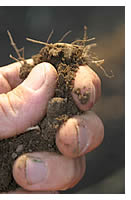 One way to see eye-to eye with nature is by exploring the farm with a
class of 1st graders (or with my 2 year old daughter, for that matter).
Just sit down on the ground. One enters a different reality; a 6 foot "giant" like
me must stop and be sensitive and smell, see, and taste the details that are
often overlooked yet which are sitting right there at my feet. During one of
these "sit-downs" with a class of preschoolers last week, everyone
had their hands in the soil digging up freshly sprouted
seed potatoes... scratching and carving, stopping to inspect the occasional earthworm,
beetle, or roly-poly, until finally pulling up the entire plant. With the potato
still dangling from its stem we started inspecting the root system, holding on
to a clump of fresh soil and marveling at the first stolons swelling into miniature
potato tubers. We also honored the healing powers of plantain – not the
tropical cousin of the banana tree, but a plant commonly found in our lawns and
gardens (never too far from anywhere) with sword-like leaves (see photo). This
little plant, considered a weed by many, is also known as nature's band-aid:
useful for treating small cuts, stings, and even poison oak rashes. After playing
with the goats and chickens we shifted our curiosity to sweeter and juicier explorations
of the farm: the strawberry patch. Here, the advantage of being smaller always
pays off as we search for the reddest and juiciest berry on each plant. Both
tummies and harvest baskets quickly filled up and I decide to savor my bounty
by sitting next to an almost mature patch of red onion and see if I couldn’t
engage the kids' curiosity in this less appealing but popular vegetable. Most
of us only know the dry cured “storage onion” we get at the store,
and never get to see a growing onion with it's long, green stems and hollow leaves.
As we gently pull one out of the ground I explain how the onion belongs to the
'Allium' family, which has been cultivated since before the Egyptians.
One way to see eye-to eye with nature is by exploring the farm with a
class of 1st graders (or with my 2 year old daughter, for that matter).
Just sit down on the ground. One enters a different reality; a 6 foot "giant" like
me must stop and be sensitive and smell, see, and taste the details that are
often overlooked yet which are sitting right there at my feet. During one of
these "sit-downs" with a class of preschoolers last week, everyone
had their hands in the soil digging up freshly sprouted
seed potatoes... scratching and carving, stopping to inspect the occasional earthworm,
beetle, or roly-poly, until finally pulling up the entire plant. With the potato
still dangling from its stem we started inspecting the root system, holding on
to a clump of fresh soil and marveling at the first stolons swelling into miniature
potato tubers. We also honored the healing powers of plantain – not the
tropical cousin of the banana tree, but a plant commonly found in our lawns and
gardens (never too far from anywhere) with sword-like leaves (see photo). This
little plant, considered a weed by many, is also known as nature's band-aid:
useful for treating small cuts, stings, and even poison oak rashes. After playing
with the goats and chickens we shifted our curiosity to sweeter and juicier explorations
of the farm: the strawberry patch. Here, the advantage of being smaller always
pays off as we search for the reddest and juiciest berry on each plant. Both
tummies and harvest baskets quickly filled up and I decide to savor my bounty
by sitting next to an almost mature patch of red onion and see if I couldn’t
engage the kids' curiosity in this less appealing but popular vegetable. Most
of us only know the dry cured “storage onion” we get at the store,
and never get to see a growing onion with it's long, green stems and hollow leaves.
As we gently pull one out of the ground I explain how the onion belongs to the
'Allium' family, which has been cultivated since before the Egyptians. 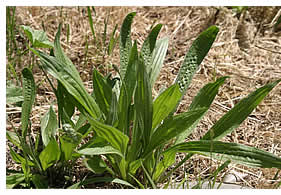 As I slice
through a bright magenta-colored bulb, passing it around for a smell test, it
doesn't take long for most kids to identify garlic as another relative of the
onion. As we walk back to the parking lot I see a girl nibbling on her shiny,
juicy onion bulb, a good sign that we have worked up an appetite to enjoy lunch.
As I slice
through a bright magenta-colored bulb, passing it around for a smell test, it
doesn't take long for most kids to identify garlic as another relative of the
onion. As we walk back to the parking lot I see a girl nibbling on her shiny,
juicy onion bulb, a good sign that we have worked up an appetite to enjoy lunch.
Harvesting and eating food that's growing right in front of you is a simple but
powerful act. It reminds you that real food comes from the earth and is not made
in factories by machines focused on profit (contrary to what the corporate marketers
want you and your children to believe). It does not contain artificial additives
or preservatives, nor is it engineered with magic tricks that scramble its genes.
Real food is not packaged nor marketed; it simply is provided by the earth and
the soil we stand upon. We are what we eat, and we should not do to food what
would be an indignity if done to us. Food is sustenance, a common thread that
links all living creatures.
Crop Notes
~~~~~~~~~~~~~~~~~~~~~~~~~~~~~~~~~~~~~~~~~~~~~~~~
The potatoes are developing beautifully and abundantly, and my best guess is
that we'll have spring potatoes before we celebrate the Summer Solstice. This
year we are doing something new: dry-farmed potatoes. These potatoes will get
no water from irrigation, only whatever falls from the skies. They are looking
beautiful though, so I am excited.
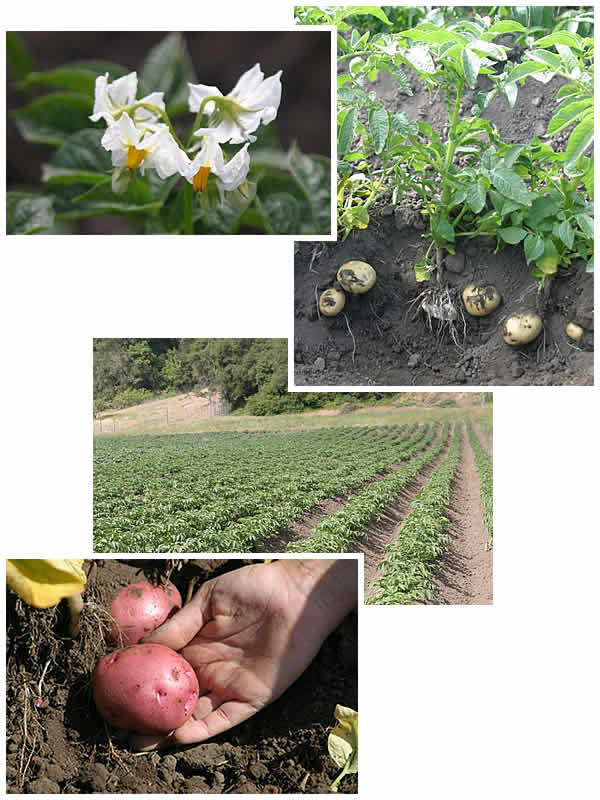
The fava beans are starting to slow, so this
may be the last week we have them in our shares. We'll harvest what we can, then
mow them down and incorporate the abundant organic matter of their tall stalks
back into the soil. We are also harvesting the last of the chantenay carrots,
so only the Family Share will be getting them this week. After that we’ll
be without carrots for a few weeks, until our new planting sizes up (approximately
3 weeks). They’ll be the long slender type, called “Nelson.”
Signs of summer are on the horizon, with the first summer squash in the box this
week! The yellow ones with the light green tips are called “zephyr” and
are just sizing up. Soon we will have plenty from our own fields and not have
to supplement with zucchinis from Lakeside. Our green beans and cucumbers will
be making their first appearances soon too – sometime in June, I expect
(the Japanese cucumbers are from nearby Nagamini Nurseries, not from us). Raspberries
and blackberries will be diversifying our fruit shares in the coming months (just
not quite yet), so in the meantime, enjoy our strawberry bounty.
<back to top>
Teen Adventure Camp Cancelled
~~~~~~~~~~~~~~~~~~~~~~~~~~~~~~~~~~~~~~~~~~~~~~~~
The Teen Adventure Camp has been cancelled this year due to a low response,
however the children’s Mini-Camp is so popular it is already full.
We are considering having two Mini-Camps next year, in order to accommodate
everyone. (Possibly even a second Mini-Camp this year; stay tuned!)
<back to top>
A note to goat milk drinkers from Lynn at Summer
Meadows Farm
~~~~~~~~~~~~~~~~~~~~~~~~~~~~~~~~~~~~~~~~~~~~~~~~
Don’t discard your goat milk if it goes sour! I have discovered
that some of my families that drink raw goat milk could use some more
info about it. We all know that raw milk has a shorter shelf-life than
pasteurized, however when raw milk gets sour it is still totally healthy
(I can’t vouch for the pasteurized,
processed stuff). Souring of raw milk is a natural process, and you can use sour
milk in any recipe that calls for sour milk or buttermilk. Our favorite is my
Grandma's pancake recipe:
4 eggs
4 cups sour milk
1 cup cornmeal
1 cup wheat or unbleached pastry flour
2 cups wheat flour
2 tsp. baking powder
2 tsp. baking soda
1/2 tsp. salt
Beat the eggs, add the milk and mix. Combine the dry ingredients, add them to
the wet, and mix. Fry pancakes on a medium-hot griddle.
This makes a lot of pancakes, so feel free to halve it.
You can freeze milk too. If you notice your milk is beginning to sour and you
don't have time to use it, you can freeze it, fresh or sour, and use it later.
Just leave headroom (in whatever container you freeze it in) for expansion in
the freezer. Our family always takes a couple gallons of frozen milk with us
when we go on our big family camping trips. They keep the coolers cold, and as
they thaw we use the milk on granola for breakfast.
So I am hoping this news will help save your milk from going down the drain when
it is still healthy and useful for you! You can also freeze your goat cheese
if you think you will be not eating it right away. It keeps well when frozen – chevre
keeps well for 6 months! My friend Nicci, the great cheese maker, says that the
pretty melon-colored mold that sometimes grows on chevre is a "friendly" mold
and can be eaten (although myself, I just scrape it off and eat the cheese).
I hope these tips are helpful! Raw milk is so healthy compared to pasteurized
milk; it behaves so differently, with natural enzymes which actually destroy
bad bacteria that may be introduced to it, helping to keep it safe and healthy
for us. Love, Lynn
<back to top>
A short message from Debbie about your pickup
site checklist
~~~~~~~~~~~~~~~~~~~~~~~~~~~~~~~~~~~~~~~~~~~~~~~~
Don’t leave important notes to us on the checklist. You may not
realize it, but I don’t see the checklists from your pick-up site
binders again until the week after you do. Each week when Luis or Joe
delivers your new shares, he then brings me back the old checklists from
the prior week. So if you leave me a note (about a problem with your
share, for example), not only won’t I
see it for a week, but I won’t be able to act upon it until yet another
week has passed. In other words, it will be two weeks before we can do anything
about what you’ve told us. It’s always a pleasure to see your “thank-you!”s
and “yum!”s (I would never discourage that!), and since they are
not time critical, they're fine. However, if there is ever an issue with your
share or about your pick-up site that we need to know, please call us (the phone
number is on the checklist, so you can call right from your pick-up site if you
have a cell phone with you), or send us an email and we can respond quicker!
Thanks!! – Debbie
Oh, and one more thing: please don’t leave payments for us in your binder
either, for the same reason. They’ll sit there for a week, and also are
at risk of falling out and getting lost when the binder is stored until the next
week’s delivery. Always mail checks to our PO box.
<back to top>
The Queen Visits: a honeybee story
~~~~~~~~~~~~~~~~~~~~~~~~~~~~~~~~~~~~~~~~~~~~~~~~
Longtime CSA member Steve Volk sent us this story and these pictures
just last week! Since we’ve been talking about the fate of bees,
we thought everyone would enjoy this. If you should ever have a swarm
land in one of your trees, don’t call an exterminator – call
a beekeeper! And if you work it right, hopefully you can keep the
bees and have your own honey (at least your own garden pollinators)!
Steve’s story... "We came home from school and went inside. Malcolm
then showed me that there were many bugs outside. I looked and saw CLOUDS of
bugs. Then I realized they were bees, and told everyone to come inside. I was
a little apprehensive. I then thought to call a friend of mine who is new to
beekeeping (but had more experience than I). He said he would bring his stuff
over and we would see if we could get them. I then started to relax and enjoy
this very cool thing of a zillion bees on the move.
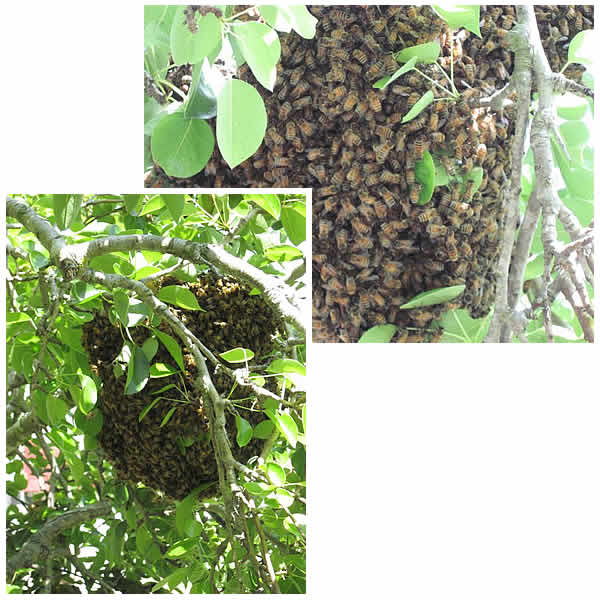
"The queen first landed in the persimmon tree and the colony swarmed around her
and quieted down. Then the yard got noisy again as 1500 bees moved to the pear
tree, where they settled down and I could see them pretty close. The colony was
the size of a volley ball!
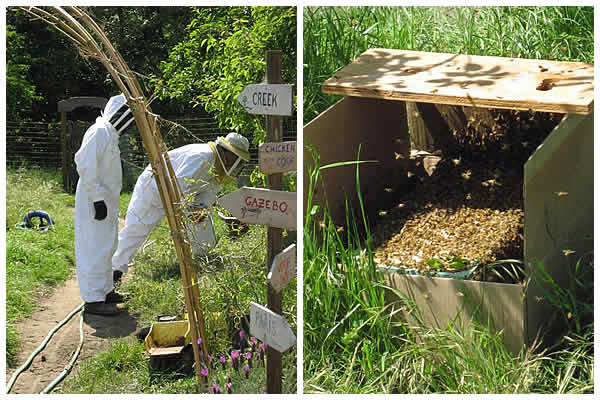
"When Dave arrived, he brought his suits, smoker, and a nucleus box to hold the
colony. We sprayed sugar water on the colony to calm them (too busy cleaning
their neighboring bee), held the box under them, shook the branch, and they fell
into the box. We felt that the Queen had not dropped (because a smaller cluster
was still hanging from the tree), so we hit the tree again and dropped them onto
the lid which we turned upside down on the box. It took 10 minutes to capture
the bees, and by 4 hours later they were settled in their new home."
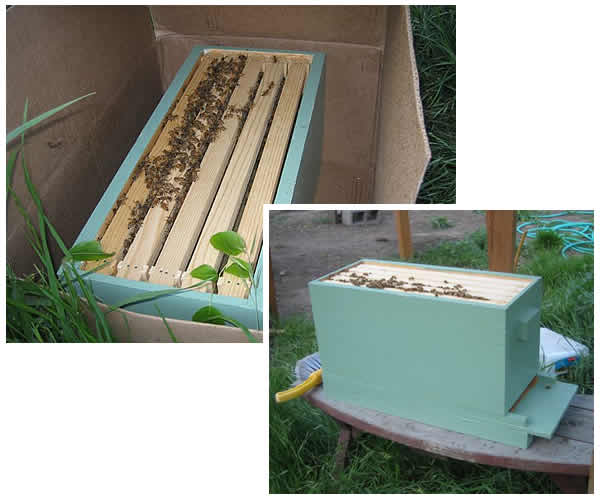
<back to top>
Pictures around the farm
~~~~~~~~~~~~~~~~~~~~~~~~~~~~~~~~~~~~~~~~~~~~~~~~
Here is Tom's daughter Elisa experimenting with an onion: harvest, peel,
lick, taste... distaste!
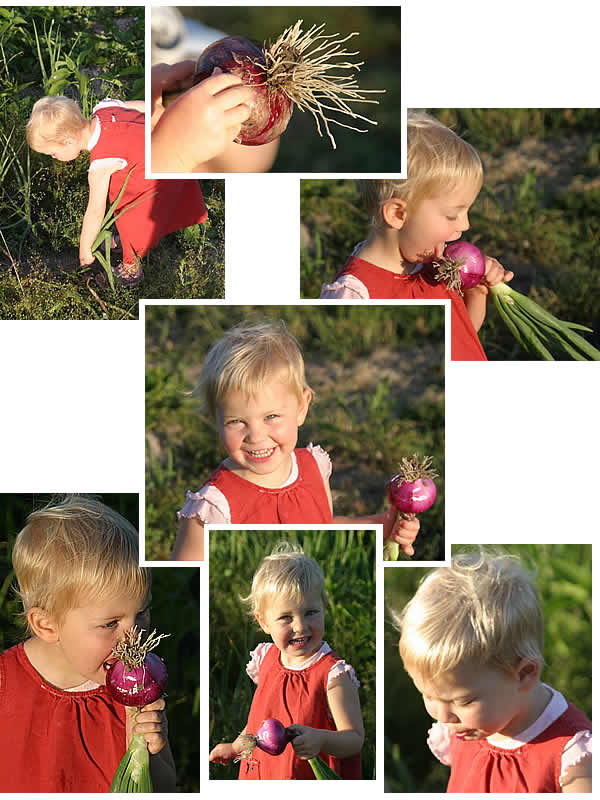
Here's an owl box in our potato field (for gopher control)...
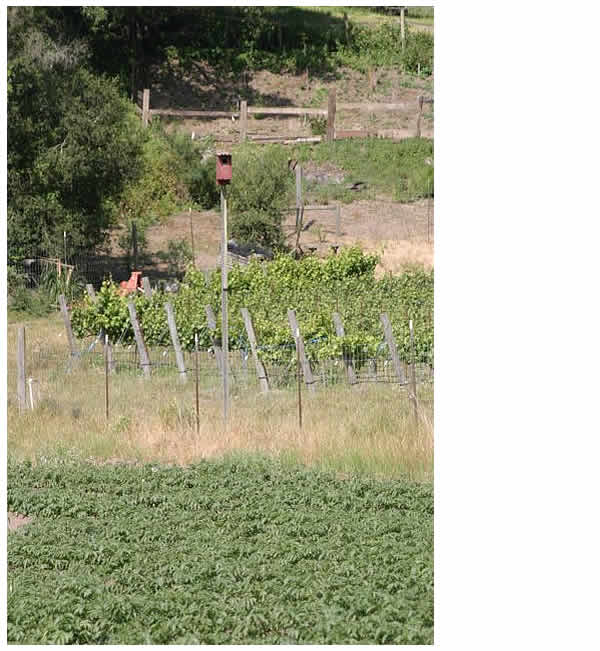
...and some baby radishes, up close and personal!
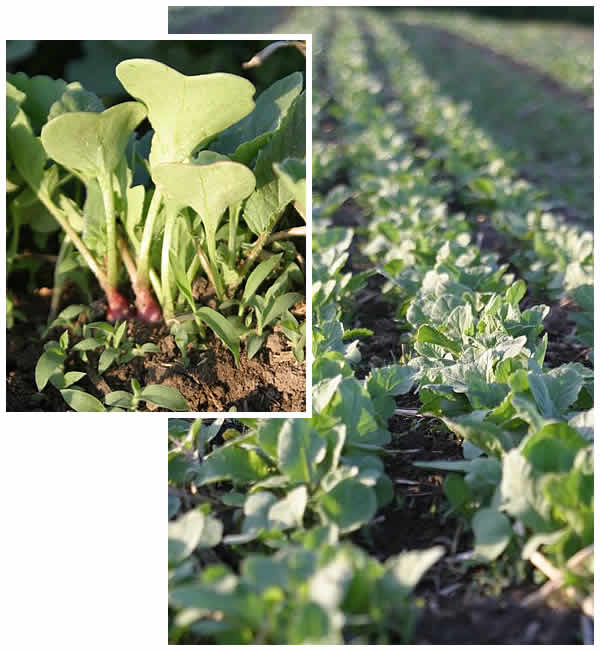
<back to top>
What's in the box this week
~~~~~~~~~~~~~~~~~~~~~~~~~~~~~~~~~~~~~~~~~~~~~~~~
(Content differences between Family and Small
Shares are underlined and italicized; items with a “+” in
Family Shares are more in quantity than in Small; anticipated quantities are
in parentheses. Sometimes the content of your share will differ from what's on
this list, but we do our best to give you an accurate projection. It's Mother
Nature that throws us the occasional curve ball!)
Family Share:
Arugula
Beets
Chinese (Napa) cabbage
Carrots
Japanese cucumbers (Nagamine Nursery) (2)
Fava beans +
Fennel (2)
Garlic +
Kale (red Russian or Dinosaur)
Lettuce +
Onions +
Zucchini (yellow zephyr from LEF and/or green from Lakeside)
Strawberries (1 bskt.)
Small Share:
Arugula
Beets
Chinese (Napa) cabbage or broccoli
Japanese cucumbers (Nagamine Nursery) (1)
Fava beans
Garlic
Kale (red Russian or Dinosaur) or chard
Lettuce
Onions
Spinach
Strawberries (1 bskt.)
Extra Fruit Option:
4 baskets of strawberries
"Strawberry Bounty" Option:
also 4 baskets of strawberries
<back to top>
Notes from Debbie's Kitchen
~~~~~~~~~~~~~~~~~~~~~~~~~~~~~~~~~~~~~~~~~~~~~~~~
What I'd do with this week's box
I am resurrecting this concept because I think it’s a nice way to encourage ‘thinking
differently’ about the contents of your box. If anyone thinks they’d
like to write a ‘what I’d do’ for a future newsletter, let
me know and I’ll give you the skinny! Meanwhile...
It’s supposed to get warm this week, so I’ll be making things that
don’t require a lot of heat in the kitchen. I’ll underline the box
ingredients, for easy spotting!
Let’s start with beets: I’d
use the
beet greens in a breakfast scramble – steam them 3 minutes until
soft, squeeze out excess moisture and chop. Sauté up some mushrooms in
butter or olive oil (once we get potatoes, I’d dice up a few into
small [quarter-inch] dice and brown them first, then add the mushrooms and proceed).
Chop up some of the light green part of the onion stems (I use them in
place of scallions). Grate some cheese and have it standing by. Whisk up a couple
eggs. Once the [potatoes and] mushrooms are done, up the heat and add the ‘scallions’ and
stir just a minute. Add the egg, and scramble; add the beet greens when
the eggs are about half-done. Generously season with salt and pepper, and as
soon as the eggs are done, turn off the heat, top with cheese and cover until
melted.
The beets themselves I’d roast (rub with oil, wrap in foil, bake in a moderate
oven around an hour), then peel and refrigerate. Then they’re handy to
slice cold into salads, or I’d do my current favorite: diced beets with
plain yogurt, a little crushed fresh garlic, a little salt, and minced fresh
dill. Eat just like that or serve on a bed of lettuce leaves. If it’s too
hot to roast them, just peel and grate them and make this same concoction with
the raw grated beets instead of diced cooked ones.
I’d make a salad with arugula, lettuce, thinly sliced cucumbers, maybe
just a touch of very thinly sliced fresh onion, toasted walnuts, crumbled chevre
or feta cheese, and sliced strawberries. For the dressing I’d combine some
lemon juice and balsamic vinegar with a dab of honey, a dab of Dijon mustard,
salt and pepper, and either olive oil or roasted walnut oil. Toss all together
and serve in big bowls!
I’ve been waiting to get Chinese cabbage because I want to try making
kimchi! See below for recipe.
I’m also a firm believer in cooking simply and letting the flavor of the
veggies shine. I know at least one dinner will include grilled fennel and zucchini.
Simply slice them in half, baste with olive oil, sprinkle with salt and pepper
and grill (for me, alongside the lamb chops). I’d make a carrot side dish
by simmering whole carrots in salted water for 10 minutes, draining, peeling
(the skins just rub off), then returning to the skillet and sautéing in
a little butter and salt.
Kale: my old standby – cook leaves in boiling salted water 2 minutes. Drain,
squeeze out water, chop, serve drizzled with good olive oil and fresh squeezed
lemon juice. Optional: top with some freshly grated parmesan cheese.
Lastly, I have this idea of making a sandwich spread out of mashed cooked fava
beans, feta cheese, sundried tomatoes and herbs! (I’m not afraid of making
things up and you shouldn’t be either!) :-) I’ll let you know how
it comes out next week after I make it.
Meanwhile, here’s a recipe a friend and fellow CSA member sent to me last
week:
Mark’s Wilted Sesame Spinach
Member Mark Stevens of Saratoga says, “I made this for dinner the other
night and it turned out well. I was trying to emulate a steamed spinach with
sautéed garlic dish that we often get from Mandarin Gourmet.”
2 green garlic
1 bag spinach
2 bunches chard
¼ to ½ C white wine
Olive oil
Sesame seed oil
Some good salt, such as Fleur de Sel
Chop the green garlic very coarsely, including the green portion as far up as
can be used. Tear the leaves of spinach and chard into large chunks (approx 2").
In some cases, this will be the entire leaf.
In a wok or equivalent, sauté chopped garlic in the olive oil, with a
little sesame oil added for taste, until the garlic is turning soft. Add wine
and bring to boil. Add chard, cover and cook until it starts to cook down (1-2
minutes). Stir the ingredients in the pan, add the spinach, and cover and steam
for another minute. Uncover and cook on high heat, stirring occasionally, for
another minute or so. Using tongs or a slotted spoon transfer vegetables from
pan into a serving bowl, making sure to include all the chopped garlic, but leaving
most of the liquid behind. Don’t squeeze the liquid out of the veggies,
but you don't want to have it swimming in the serving bowl either. Add salt to
taste and serve immediately.
As a variation, you could chop the chard stems and sauté them for a few
minutes before you add the garlic, and then proceed from that point. I did not
use the chard stems when I did the recipe.
Kimchi
from “Wild Fermentation” by Sandor Ellix Katz [this is a fabulous
book, by the way! Again, my comments are in square brackets, Sandor’s are
in parentheses. – Debbie]
Ingredients (for 1 quart kimchi)
Sea salt or Himalayan salt [do NOT use table salt; it has additives – read
the label sometime and you’ll be amazed. It has to be pure, unadulterated
salt because any added chemicals will mess up the fermentation process!]
1 lb. Chinese (Napa) cabbage or bok choi
1 daikon radish, or a few red radishes
1 to 2 carrots
1 to 2 onions and/or leeks and/or a few scallions and/or shallots (or more!)
3 to 4 cloves of garlic (or more!)
3 to 4 hot red chilies (or more!), depending on how hot-peppery you like food,
or any form of hot pepper, fresh, dried, or in a sauce (without chemical preservatives!)
3 tbsp. (or more!) fresh grated gingerroot
Process
1. Mix a brine of about 4 C water and 4 tbsp. salt. Stir well to thoroughly dissolve
salt. The brine should taste good and salty.
2. Coarsely chop the cabbage, slice the radish and carrots, and let the vegetables
soak in the brine, covered by a plate or other weight to keep them submerged,
until soft, a few hours or overnight. Add other vegetables to the brine such
as snow peas, seaweeds, Jerusalem artichokes, anything you like.
3. Prepare spices: Grate the ginger; chop the garlic and onion; remove seeds
from the chilies and chop or crush, or throw them in whole. Kimchi can absorb
a lot of spice. Experiment with quantities and don’t worry too much about
them. Mix spices into a paste. (If you wish, you can add fish sauce to the spice
paste. Just check the label to be sure it has no chemical preservatives, which
function to inhibit microorganisms [needed for proper fermentation].)
4. Drain brine off vegetables, reserving brine. Taste vegetables for saltiness.
You want them to taste decidedly salty, but not unpleasantly so. If they are
too salty, rinse them. If you cannot taste salt, sprinkle with a couple of teaspoons
salt and mix. [The salt is necessary to the fermentation process.]
5. Mix the vegetables with the ginger-chili-onion-garlic paste. Mix everything
together thoroughly and stuff it into a clean quart-size (liter) jar. Pack it
tightly into the jar, pressing down until the brine rises. If necessary, add
a little of the reserved vegetable-soaking brine to submerge the vegetables.
Weight them down with a smaller jar, or a sip-lock bag filled with some brine
[so that if it leaks, no problem. The purpose of the weight is to keep the veggies
fully submerged during fermentation.] Or if you think you can remember to check
the kimchi every day, you can just use your (clean!) fingers to push the vegetables
back under the brine. I myself like the tactile involvement of this method, and
I especially enjoy tasting the kimchi by licking my fingers after I do this.
Either way, cover the jar to keep out dust and flies.
6. Ferment in your kitchen or other warm place. Taste the kimchi every day. After
about a week of fermentation, when it tastes ripe, move it to the refrigerator.
An alternative and more traditional method is to ferment kimchi more slowly and
with more salt in a cool spot, such as a hole in the ground, or a cellar or other
cool place.
Debbie’s Salad Dressings
A couple times I’ve gotten emails from members asking for salad dressing
recipes. Well now that I have the luxury of space in the electronic newsletter,
I can give you a whole bunch of ideas!
First though, I want to share with you this wonderful meditation on lettuce (and
dressing it for salads), written over 30 years ago by Edward Espe Brown in his
book “Tassajara Cooking.” I feel it provides the perfect segue into
a good mindset for thinking about salad dressing! Here ‘tis:
“The idea is that somebody is going to eat some lettuce. Why not just rinse
off the earth and serve it? If you appreciate and enjoy lettuce like this and
the other people eating do also, read no further, nothing could be simpler. But
maybe a little salt is added to bring out its natural taste. What happens when
salt is added is that water is drawn out of the lettuce. It goes limp, loses
its crisp. With cabbage this is appropriate, but lettuce leaves, more delicate
than cabbage, don’t have crisp to spare. The answer to this is to get the
lettuce coated with oil first. The salt won’t penetrate nearly as fast.
But now the lettuce is sure gummed up with oil. What cuts oil is vinegar. A bit
of zing, too, not bad. So that’s the basic dressing: oil, vinegar and salt.
Beyond this basic dressing we can explore ways to further amplify, mollify, pacify.”
Isn’t that great? I just love his writing. His philosophy. Anyway, here’s
how I make salad dressings. I never make big batches of the stuff; I prefer to
make just enough to dress whatever salad I’m making at the moment. I use
an old teacup and a fork to whisk the dressing with. So simple.
So below I’m going to give you several dressing combos that I make all
the time. And keep in mind, the list is by no means exhaustive! Remember, there
are almost infinite variations on the ol’ oil-vinegar-salt combo. Sometimes
for sour I use lemon juice or lime juice, and for salty I use soy sauce, sometimes
fish sauce. Or anchovies, or anchovy paste. And so many oils! My most often favorites
are olive oil or roasted walnut oil, and I’ll sneak a little fresh flaxseed
oil in when I can (good for you; I prefer it in sweeter dressings... has a nice
flavor) but I’ll also use toasted sesame oil and occasionally simply canola
(if I don’t want the oil to overwhelm a delicate dressing). Vinegars I
like: balsamic, of course, and fruity vinegars such as raspberry or fig; red
wine vinegar, good cider vinegar, seasoned rice vinegar, champagne vinegar, sherry
vinegar... And then there are other flavorings like garlic, pepper (black, paprika,
chili), and fresh herbs. (Next week I’m going to talk more about fresh
herbs. Hopefully by the end of the season I’ll have every member growing
their own fresh herbs in their yard or in pots on their windowsills! You’ll
see.) And don’t forget the Dijon (or other) mustard! I put a little in
lots of dressings I make.
When I make a salad, I try to think about what else I’ll be having as a
part of the meal. If the overall meal is salty or savory, I like to make a salad
with a fruity dressing to compliment it. If there’s a sweetness to the
meal (like a fruity tomato sauce or sweet vegetables like, say, carrots cooked
in butter, honey and orange juice, or a meat stew with fruit in it, or greens
sautéed with nuts and raisins) I like to make the salad savory. If I am
making an oriental stir-fry or something, I’ll make the simplest salad
of all: I’ll just tear up plain lettuce (something tender and delicate
like red leaf or butter lettuce) and make a dressing of seasoned rice vinegar
and toasted sesame oil. Seasoned rice vinegar means it has already been flavored
with a little sugar and salt, so all you need to add is the oil! That’s
what I’ll start with.
Rice vinegar/sesame oil – the easiest of all!
Just like it sounds. A little seasoned rice vinegar (be sure to read the end
of the above paragraph if you’re jumping down to this!), a little toasted
sesame oil. Sometimes toasted sesame oil is a little strong, so I’ll cut
it with a little canola (or just not use too much of it). When you start making
your own dressings regularly, you’ll get the hang of quantities! Whisk
it together with a fork until it emulsifies.
Cilantro-lime-soy
I love this one! Fresh lime juice (or lemon juice), a small clove of fresh garlic,
crushed, soy sauce, and olive oil. And a bunch of finely chopped up cilantro.
It’s really good if you can add some feta to the salad too. I like using
this dressing on spinach and arugula, but will also use it on most lettuces or
any combination of lettuces!
Simple balsamic dressing
A little balsamic vinegar, a little olive oil, and a pinch of salt. Whisk together
with a fork.
Variations on simple balsamic dressing
<> Add a dab of Dijon mustard (prepared mustard, not the dry kind), and
some black pepper.
<> Add a dab of Dijon mustard and a little honey.
Balsamic dressing is great on salads that have a little bleu cheese and toasted
nuts in them!
Deb’s favorite fruity dressing
Black fig vinegar, dab of Dijon, dab of honey, bit of lemon juice, salt, pepper,
and roasted walnut oil (with a blort of flaxseed oil for good measure, though
this is completely optional!). I will sometimes make this self-same dressing
and use olive oil instead of walnut oil. Still good. This is particularly good
on a green salad (arugula, lettuce, mustard greens – whatever) with fresh
strawberries! If you have it, add some crumbled chevre or feta cheese. And some
thinly sliced onion if you like. And some toasted nuts if you’re in the
mood. All of these things can be added or not, as your mood suites you or time
(or pantry) allows.
Deb’s fruity dressing #2
This is good in the fall, when we have apples. Cider vinegar, dab of Dijon mustard,
dab of honey, salt, and a goodly amount of paprika, and that walnut oil again;
although if I’m out of walnut oil this is fine with canola or olive oil.
Whisk until all is emulsified. This is great on a lettuce salad that has cut
up apples, carrots, celery, walnuts, onion and feta cheese! Again, if you don’t
have one of these things, leave it out. If all I have is lettuce and apples and
carrots, I’ll just use that. Don’t panic; it’s just salad.
Simple vinegar and oil
A good red wine vinegar (I recently found a cabernet vinegar that is wonderful,
but whatever you have is fine), olive oil, and salt and pepper. Add a little
crushed garlic if you like (or not if you don’t). Sometimes I’ll
add a pinch of dried herbs de Provence; rub them between your fingers to release
the flavors then whisk in.
Deb’s Caesar Dressing
Haven’t ever tried making this with raw egg (although a friend made me
a Caesar salad with egg in it – Alie, would you be willing to describe
your fabulous Caesar salad for a future newsletter? Send it to me now and I’ll
use it next time we get romaine). This is one dressing I do use only when I have
romaine lettuce in my box. In my version of Caesar dressing I put a little bit
of a lot of things: lemon juice, vinegar (red wine, white wine, or sherry or
similar; just not balsamic), dash of Worcestershire sauce, dab of Dijon mustard,
crushed (small) clove of garlic, anchovy paste (or mashed anchovies, or put anchovies
in the salad), and olive oil. Whisk together until blended, then toss chopped
romaine with this. Then liberally sprinkle on freshly ground black pepper, and
lastly grate on a bunch of fresh Parmesan cheese and toss to mix well. Add croutons
or not, as you like.
I could go on, but these are my more favorite (and commonly used) ones. I hope
I have inspired you to make up some dressings of your own!
<back to top>
Calendar of Events
~~~~~~~~~~~~~~~~~~~~~~~~~~~~~~~~~~~~~~~~~~~~~~~~
(see calendar on website for more info)
<> Fri. May 18, Four Fridays Mataganza Garden Internship (5/18, 5/25, 6/1,
6/8)
<>
Sat. Jun 9 Outstanding in the Field Dinner
<> Sat. Jun 23 Summer Solstice
Celebration
<> July 10-14 Teen Adventure Camp <cancelled>
<> Aug 24-26 Childrens Mini-Camp
<>
Sat. Oct 20 Fall Harvest Celebration
<back to top>
Contact Information
~~~~~~~~~~~~~~~~~~~~~~~~~~~
email the farm: farmers@cruzio.com
email Debbie with newsletter input or recipes: deb@writerguy.com
phone: 831.763.2448
web: http://www.liveearthfarm.net
~~~~~~~~~~~~~~~~~~~~~~~~~~~